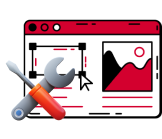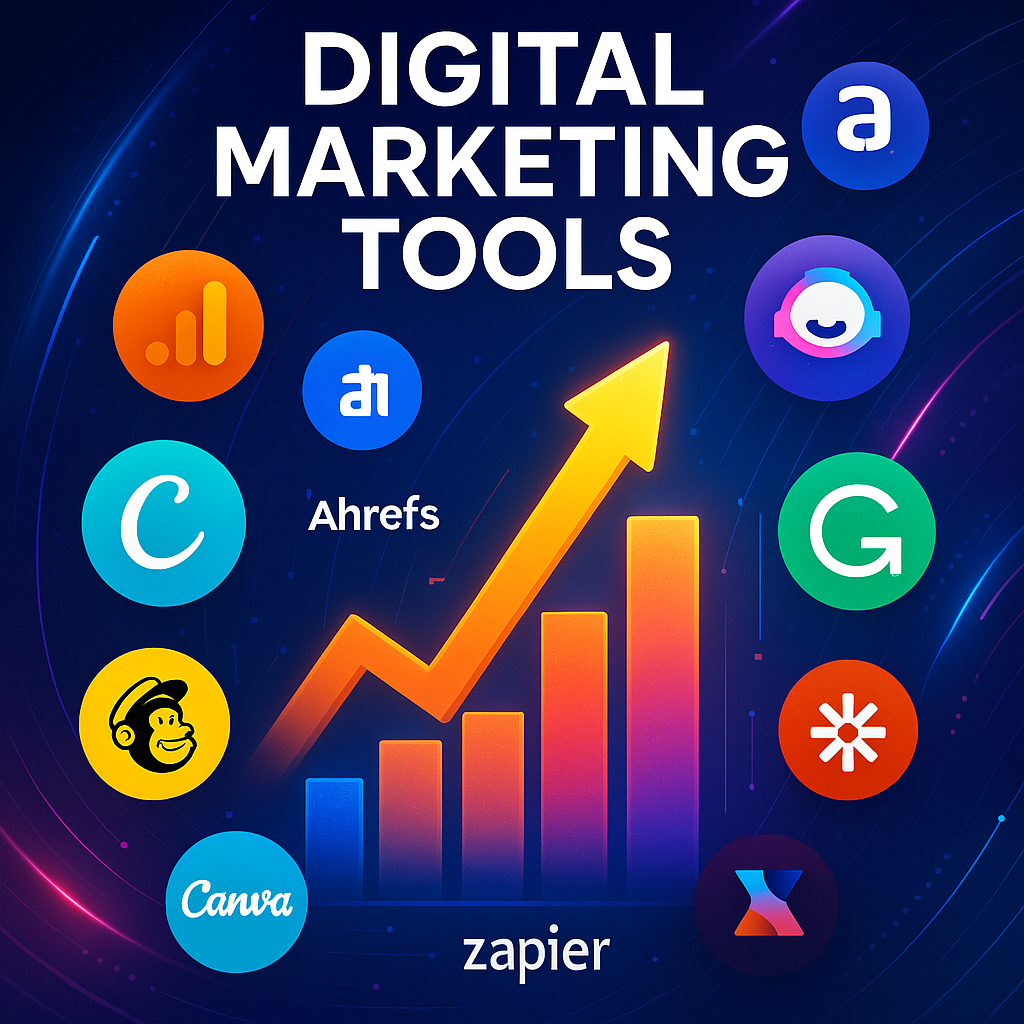Introduction: Why Choosing the Right Tools Matters in 2025
In 2025, digital marketing is no longer just about running ads or posting content. It’s about using the right tools to track, analyze, create, automate, and scale your entire marketing strategy. With the rise of AI, changing algorithms, and multi-platform campaigns, having the correct digital marketing stack can significantly impact your results.
Many marketers waste hours switching between platforms or relying on outdated systems that don’t support today’s needs. To compete in this fast-paced environment, marketers need tools that deliver real-time insights, save time, reduce costs, and improve outcomes.
This guide covers the 25 best digital marketing tools of 2025 across all major categories, including SEO, email marketing, content creation, automation, analytics, and more. Each tool listed is highly rated, actively used by professionals, and proven to deliver results.
1. Google Analytics 4 (GA4)
Category: Analytics
Purpose: Track website and app performance
Google Analytics 4 is now the industry standard for tracking user behavior. As of 2025, Universal Analytics is fully retired, and GA4 provides deeper insights across platforms using event-based tracking.
Key Features:
- Real-time reporting across devices
- Predictive analytics (like potential conversions or churn)
- Seamless integration with Google Ads
- Advanced funnel and audience building
Why Marketers Use It in 2025:
Marketers rely on GA4 to understand what content drives traffic, where users drop off, and which campaigns convert. With its AI-driven suggestions and custom reporting dashboards, GA4 turns raw data into actionable steps. This tool is essential for any marketer managing websites, e-commerce platforms, or mobile apps.
Marketing Tip:
Set up custom events for every step of your customer journey — such as scroll depth, add-to-cart, form submissions, and video completions. Then, create audiences based on these micro-conversions in GA4 and link them to Google Ads. This allows you to build high-intent retargeting segments and personalized remarketing campaigns that improve ROI.
2. Semrush
Category: SEO, Competitor Analysis
Purpose: Improve organic traffic and outrank competitors
Semrush remains one of the most comprehensive SEO platforms in 2025. It offers a full suite of tools for keyword research, site audits, backlink tracking, and PPC insights.
Key Features:
- Keyword Magic Tool with real-time volume trends
- Site Audit Tool to fix on-page SEO issues
- Domain Overview for Competitive Analysis
- Position Tracking for monitoring keyword rankings
Why Marketers Use It in 2025:
With constant changes in Google’s algorithm, marketers use Semrush to stay one step ahead. It’s particularly effective for content planning and finding keyword gaps that competitors aren’t targeting. If you want your blog or product pages to rank for terms like “best digital marketing tools,” Semrush helps you make it happen.
Marketing Tip:
Use the Keyword Gap tool to analyze competitor domains and uncover keyword opportunities they're ranking for — but you’re not. Then, filter by "untapped" and "weak" keywords to build a content plan around easy-win topics. Pair this with the SEO Content Template tool to generate optimized content that outperforms your competitors.
3. Ahrefs
Category: SEO, Backlink Research
Purpose: Build better content and link strategies
Ahrefs is the go-to platform for backlink data and competitive SEO insights. With one of the largest backlink databases in the world, it offers unmatched visibility into what’s working for others in your niche.
Key Features:
- Site Explorer to analyze traffic and backlink profiles
- Keyword Explorer for new content opportunities
- Content Gap tool to discover what your site is missing
- Alerts for new or lost backlinks
Why Marketers Use It in 2025:
Backlinks remain a top-ranking factor, and Ahrefs helps marketers find the best opportunities to build them. For brands aiming to increase domain authority or run outreach campaigns, Ahrefs is a daily-use tool. It also helps identify which pages bring in the most traffic and why.
Marketing Tip:
Filter Content Explorer by "referring domains" and "publish date" to identify top-performing content in your niche. Then reverse engineer that content by checking their backlink profiles and keywords. Recreate a better version of it, optimize it with on-page best practices, and reach out to those same backlink sources with a link-building pitch.
4. Surfer SEO
Category: Content Optimization
Purpose: Write content that ranks higher in search engines
Surfer SEO blends data with writing. It shows exactly how to optimize your content based on what already ranks in the top 10 on Google.
Key Features:
- Real-time SEO score as you write
- NLP-based keyword suggestions
- Competitor content analysis
- SERP data with visual layout guides
Why Marketers Use It in 2025:
Content is still king, but content alone doesn’t rank—optimized content does. Marketers use Surfer SEO to craft blog posts, landing pages, and product content that align with Google’s current ranking factors. For example, using Surfer to optimize a blog targeting “digital marketing tools for e-commerce” can significantly improve its ranking potential.
Marketing Tip:
Before writing a blog post, input your focus keyword into Surfer's Content Editor and review the top 10 ranking pages. Use its NLP recommendations to naturally include related phrases and semantic keywords. Then, optimize headings, paragraph length, and image count to mirror what's working for top-ranking pages — while still writing in your tone.
5. Canva
Category: Visual Content Creation
Purpose: Design professional graphics, social posts, and marketing materials
In 2025, visual content will drive clicks, shares, and conversions. Canva remains the top tool for creating professional-looking designs without needing advanced design skills.
Key Features:
- Pre-built templates for every platform (social, ads, banners, presentations)
- Brand kit management for consistent visuals
- Team collaboration and commenting
- Video editing and animation support
Why Marketers Use It in 2025:
From creating Instagram carousels to YouTube thumbnails or ad creatives, Canva does it all in one place. It speeds up content production without sacrificing quality. For small teams or solopreneurs, it’s the fastest way to produce agency-level design without hiring a designer.
Marketing Tip:
Use Canva’s content planner to schedule visual posts directly to your social platforms. Combine this with Magic Resize to quickly repurpose a high-performing Instagram post into Pinterest, LinkedIn, and Facebook formats. This lets you maintain consistent branding and saves hours each week on design work.
6. HubSpot
Category: CRM, Email Marketing, Automation
Purpose: Manage customer relationships and automate marketing workflows
HubSpot will remain a cornerstone of modern marketing stacks in 2025. It combines CRM, email marketing, social scheduling, landing page creation, and automation—all in one platform.
Key Features:
- Built-in CRM to track leads, deals, and contacts
- Email automation and A/B testing
- Custom landing page builder with templates
- Social media monitoring and scheduling
- Integration with over 1,000 apps and tools
Why Marketers Use It in 2025:
HubSpot gives a full view of your customer journey—from first visit to conversion. It’s used by startups and enterprises alike to centralize marketing and sales efforts. If you want to automate your lead nurturing and see exactly how your digital marketing tools influence conversions, HubSpot offers the complete picture.
Marketing Tip:
Automate your entire lead nurturing journey by setting up HubSpot Workflows. Start with an email drip campaign triggered by a lead magnet download. Then create a branching logic based on user behavior — for example, opening the second email or clicking a product link — and push leads into different content tracks. This drives better engagement and sales without manual follow-up.
7. Mailchimp
Category: Email Marketing
Purpose: Build and manage email campaigns that convert
Mailchimp has evolved into more than just an email marketing tool. In 2025, it serves as a lightweight marketing automation and e-commerce assistant for small to medium-sized businesses.
Key Features:
- Drag-and-drop email builder
- AI-powered content suggestions
- List segmentation and audience analytics
- Pre-built journey automation
- Product recommendations for e-commerce
Why Marketers Use It in 2025:
Email still delivers one of the highest ROIs among all marketing channels. Mailchimp helps businesses of all sizes launch professional, high-converting email campaigns without coding or complex setup. It’s especially useful for newsletters, product announcements, and re-engagement campaigns.
Marketing Tip:
Segment your email list based on behavior tags — like "clicked product link" or "abandoned cart" — then create automated product recommendation emails using dynamic content blocks. This increases your open and click-through rates while improving your chances of converting passive leads into buyers.
8. Notion
Category: Project Management, Content Planning
Purpose: Organize campaigns, content calendars, and internal docs
Notion is the favorite workspace tool for marketers who want everything in one place—strategy docs, blog calendars, checklists, and campaign boards.
Key Features:
- Drag-and-drop content calendar
- Custom dashboards and marketing wikis
- Real-time collaboration
- Notion AI for writing help and idea generation
- Seamless integration with tools like Slack, Zapier, and Trello
Why Marketers Use It in 2025:
Content and campaign planning can get chaotic fast. Notion keeps your team organized and aligned. Marketers use it to track content production, manage ideas, and document SOPs—all from a single dashboard.
Marketing Tip:
Build a custom content calendar using databases and relational links. You can track blog post statuses, assign writers, integrate publishing deadlines, and even embed analytics widgets. For teams, this becomes a centralized content hub that streamlines production and ensures consistency.
9. Buffer
Category: Social Media Management
Purpose: Schedule, publish, and analyze social media content
Buffer helps marketers maintain a consistent social media presence without logging into each platform daily. It's lightweight, affordable, and perfect for small businesses or creators.
Key Features:
- Queue and schedule posts for Instagram, Facebook, Twitter (X), LinkedIn, Pinterest
- In-depth post analytics and engagement tracking
- Visual planning calendar
- Team collaboration and approval workflows
Why Marketers Use It in 2025:
Consistency is key on social media. Buffer makes it easy to plan and automate posts across multiple platforms, review performance, and engage with followers. It’s often the first social media tool marketers invest in before moving to more advanced platforms.
Marketing Tip:
Use Buffer’s analytics feature to find your top-performing posts by channel, then re-share those high-engagement posts every 60–90 days using the "Re-Buffer" tool. This keeps your best content visible without having to create from scratch, saving time while boosting results.
10. Hootsuite
Category: Social Media Management
Purpose: Enterprise-grade social planning and listening
Hootsuite offers broader capabilities than Buffer, including listening tools and ad integrations. It’s used by larger teams who manage complex social strategies.
Key Features:
- All-in-one dashboard for publishing, monitoring, and responding
- Social listening and hashtag monitoring
- Paid ad management for Facebook and Instagram
- Custom reports and team roles
- Inbox to respond to messages across platforms
Why Marketers Use It in 2025:
For brands managing high-volume content or multiple team members, Hootsuite provides the control and oversight needed. It’s especially useful for agencies or in-house teams handling global campaigns.
Marketing Tip:
Monitor brand mentions and industry hashtags in real-time using Hootsuite Streams. Then jump into relevant conversations or respond to feedback within seconds. This boosts engagement, improves social listening, and helps with real-time customer service management.
11. Jasper AI
Category: AI Content Writing
Purpose: Generate blog posts, ad copy, emails, and more using AI
Jasper AI is one of the leading AI writing assistants in 2025, trusted by content marketers, copywriters, and agencies to create fast, high-quality content at scale.
Key Features:
- 50+ templates for blog posts, product descriptions, ads, and more
- Brand voice feature to keep your messaging consistent
- SEO mode powered by Surfer SEO integration
- Multilingual support for global campaigns
- Long-form assistant for writing entire blog posts
Why Marketers Use It in 2025:
Creating content consistently is one of the biggest challenges. Jasper helps marketers generate engaging, on-brand content in minutes. It’s especially helpful for writing product pages, social media captions, email sequences, and ad copy when speed and scale matter.
Marketing Tip:
Create long-form blog content by setting up custom templates and using Jasper’s Boss Mode. Add detailed commands like “Write an intro paragraph about SEO strategies for 2025” and let Jasper handle the structure. This helps scale content production for SEO without sacrificing quality.
12. Grammarly
Category: Writing Assistant
Purpose: Improve writing clarity, grammar, and tone across all platforms
Grammarly is more than a spell-check tool. It acts as a writing coach, helping marketers communicate clearly and professionally in every piece of content.
Key Features:
- Real-time grammar and punctuation suggestions
- Tone detection and sentence clarity improvements
- AI rewrite options for better phrasing
- Plagiarism checker (Premium)
- Integration with Google Docs, email, social, and more
Why Marketers Use It in 2025:
Every email, ad, and blog post you publish reflects your brand. Grammarly ensures your writing is polished, concise, and on-brand. It's a non-negotiable tool for marketers producing high volumes of content or managing a team of writers.
Marketing Tip:
Use Grammarly’s tone detection to tailor emails and ad copy to the emotion of your audience. A formal tone works well for B2B campaigns, while a friendly tone suits social media captions. Consistency in voice builds brand trust and improves engagement.
13. Zapier
Category: Automation
Purpose: Connect your favorite apps and automate workflows
Zapier saves hours of manual work by automating repetitive tasks across tools. It connects over 5,000 apps so your CRM, email platform, and forms can work together seamlessly.
Key Features:
- Create custom workflows (Zaps) without coding
- Triggers and actions between tools like Google Sheets, Mailchimp, Slack, HubSpot
- Multi-step automation sequences
- Filters and conditions for smarter workflows
- Real-time error logging
Why Marketers Use It in 2025:
Automation is no longer optional. Zapier lets marketers eliminate bottlenecks and repetitive tasks. For example, you can automatically add webinar signups to your email list, notify your team on Slack, and send a follow-up sequence—without lifting a finger.
Marketing Tip:
Connect Facebook Lead Ads to Google Sheets or your CRM using Zapier, and instantly send a welcome email via Mailchimp. Automating these workflows helps you respond to leads within seconds, which boosts conversion rates and simplifies your marketing stack.
14. ChatGPT
Category: AI Assistant
Purpose: Research, brainstorm, outline, and write content quickly
ChatGPT continues to be a go-to tool for marketers in 2025. It supports content creation, data analysis, research summaries, strategy planning, and even coding small tools or widgets.
Key Features:
- Generate blog outlines, emails, social posts, and ad copy
- Summarize long articles and reports instantly
- Brainstorm ideas and keyword variations
- Available as browser extension, desktop app, and mobile
- Integrates with third-party tools via plugins and APIs
Why Marketers Use It in 2025:
ChatGPT is the Swiss Army knife for marketers. It helps with quick content generation, research tasks, or even editing long-form articles. Many marketers use it as a virtual assistant to speed up writing, planning, and optimization.
Marketing Tip:
Use ChatGPT to generate content outlines, ad copy variations, or even webinar scripts. Give it a clear role (e.g., “act as a SaaS content strategist”) and detailed prompts. You’ll get faster drafts, more ideas, and consistent messaging across platforms.
15. Google Search Console
Category: SEO and Web Performance
Purpose: Monitor how your site performs in Google search results
Google Search Console provides free insights straight from Google about how your website is performing in organic search. It’s essential for fixing indexing issues, tracking keyword rankings, and measuring search visibility.
Key Features:
- Monitor search impressions, clicks, and CTR
- Track performance by page, query, country, or device
- Submit sitemaps and request indexing
- View and fix mobile usability and Core Web Vitals issues
- Receive alerts for crawl errors and penalties
Why Marketers Use It in 2025:
GSC helps marketers understand what pages rank, what keywords bring in traffic, and what technical issues block performance. It’s a real-time feedback loop between your content and Google’s algorithm. For ranking on competitive terms like “digital marketing tools,” this tool is critical.
Marketing Tip:
Use the Performance report to find pages with high impressions but low CTR. Then optimize meta titles and descriptions for those pages. You can instantly boost traffic without building backlinks or writing new content.
16. Loom
Category: Video Communication
Purpose: Record and share quick videos for training, marketing, or communication
Loom is the fastest way to create videos for your team, clients, or audience. Marketers use it to give visual feedback, walk through dashboards, or record training tutorials without setting up full video production.
Key Features:
- Screen and webcam recording
- Shareable links with no download required
- Video trimming and call-to-action overlays
- Viewer analytics (who watched, how long)
- Folder and workspace organization for teams
Why Marketers Use It in 2025:
Loom improves communication and engagement. You can record product walkthroughs, content briefs, or even personalized client updates. It’s especially effective for sales enablement, onboarding, and reducing back-and-forth emails.
Marketing Tip:
Use Loom to record quick, personalized video pitches or client updates. Embedding these into email outreach or proposal follow-ups adds a human touch that increases reply rates and builds trust. It’s also great for onboarding tutorials and internal communication.
17. Trello
Category: Project Management
Purpose: Organize marketing projects and content workflows
Trello uses a simple board-and-card format that works perfectly for content calendars, campaign planning, and task tracking.
Key Features:
- Drag-and-drop kanban boards
- Labels, checklists, and deadlines
- Team collaboration and activity tracking
- Power-Ups to integrate with Google Drive, Slack, etc.
- Automation with Trello’s native Butler tool
Why Marketers Use It in 2025:
Trello offers a lightweight, visual way to manage campaigns without overwhelming your team. Many marketers use it to plan blog topics, monitor ad campaigns, or track client deliverables—especially in small teams or freelancer workflows.
Marketing Tip:
Create a Trello board as a content workflow hub with columns for stages like “Ideas,” “In Progress,” “Editing,” “Scheduled,” and “Published.” Add custom labels like "SEO Optimized" or "Needs Review" to maintain clarity. This keeps your marketing team aligned and deadlines visible at a glance.
18. Metricool
Category: Analytics & Reporting
Purpose: Measure and manage performance across multiple channels
Metricool gives marketers a central dashboard for tracking the performance of websites, social media, ads, and email—all in one place.
Key Features:
- Real-time web and social analytics
- Ad performance tracking (Google Ads, Facebook Ads)
- Content scheduling and auto-posting
- Competitor monitoring
- Custom PDF reports with branded templates
Why Marketers Use It in 2025:
Tracking everything from one place saves time and improves decision-making. Metricool simplifies reporting for agencies, freelancers, and e-commerce marketers who need to show results and adjust fast.
Marketing Tip:
Use Metricool to schedule and analyze content across all major platforms — Facebook, Instagram, LinkedIn, YouTube, and even Google Business Profile. Study heatmaps of your publishing activity and engagement to find the best posting times, then automate evergreen post recycling.
19. Ubersuggest
Category: Keyword Research, SEO
Purpose: Find keyword ideas, track rankings, and audit your site
Ubersuggest by Neil Patel has become a user-friendly alternative to more complex SEO tools. It’s especially popular among beginners and small business owners.
Key Features:
- Keyword suggestions with volume, difficulty, and trends
- Competitor domain overview
- Daily rank tracking
- Site audit with health score and error suggestions
- Content ideas based on search trends
Why Marketers Use It in 2025:
Marketers use Ubersuggest to quickly identify keyword opportunities and optimize pages. It’s a strong starting point for SEO strategy, helping you target topics like “free digital marketing tools” or “AI tools for content marketing” with minimal complexity.
Marketing Tip:
Take advantage of Ubersuggest’s "Top SEO Pages" feature to see which competitor pages get the most traffic. Use those insights to find content gaps and identify keyword clusters for your next content pillar. Combine this with the Keyword Ideas tool to map out a full editorial calendar.
20. ClickUp
Category: Task and Team Management
Purpose: Manage everything from campaigns to client projects in one workspace
ClickUp is an all-in-one productivity tool designed to replace scattered tools like Trello, Asana, and Google Docs. It’s ideal for managing high-volume content pipelines or large marketing teams.
Key Features:
- List, board, calendar, Gantt, and workload views
- Docs, tasks, sprints, and goals in one workspace
- Time tracking and automations
- Built-in chat and team collaboration
- Integrations with over 1,000 tools
Why Marketers Use It in 2025:
ClickUp centralizes marketing operations and boosts productivity. You can manage content calendars, assign tasks, track progress, and even build campaign SOPs—without switching tabs or tools. For fast-growing teams, it becomes the command center.
Marketing Tip:
Build a marketing operations dashboard inside ClickUp with views for campaigns, assets, deadlines, and KPIs. Set custom automations that notify stakeholders when a task moves to "Review" or "Ready to Publish." This cuts down on project delays and improves cross-functional collaboration.
21. Writesonic
Category: AI Content & Copywriting
Purpose: Create SEO-optimized blog posts, ads, landing pages, and e-commerce content
Writesonic is an AI-powered writing platform designed for marketers, e-commerce store owners, and content creators who need high-converting copy fast.
Key Features:
- Blog article writer with SEO optimization
- Product descriptions for Shopify, Amazon, and WooCommerce
- Ad copy generator for Facebook, Google, and LinkedIn Ads
- Landing page builder using AI
- Surfer SEO integration for optimized content
- Article rewriting, summarizing, and idea generation tools
Why Marketers Use It in 2025:
Writesonic is perfect for teams that want fast, scalable, and keyword-rich content. Its AI tools help generate full blog posts or product pages in minutes, which is essential for ranking content like “best digital marketing tools” or scaling e-commerce content across hundreds of SKUs. It's widely praised for accuracy, tone flexibility, and ease of use.
Marketing Tip:
Use Writesonic’s “Article Writer 5.0” to create first drafts for high-intent blog topics identified through tools like Ahrefs or Semrush. Then switch to its “Landing Page Generator” for A/B testing your ad campaigns, especially for PPC or product launches. For better brand consistency, train the AI with your tone of voice and product details using Writesonic’s Brand Voice features.
22. AnswerThePublic
Category: Keyword & Topic Research
Purpose: Discover what questions people are asking in your niche
AnswerThePublic provides raw insight into your audience’s questions and search behavior. It turns a seed keyword into hundreds of search queries and content angles.
Key Features:
- Visual keyword cloud organized by questions, comparisons, and prepositions
- Keyword suggestions in the “who, what, why, when” format
- Trending topics and autocomplete data from Google
- CSV export for content planning
- Regional filtering
Why Marketers Use It in 2025:
This tool helps uncover content opportunities no keyword tool alone can show. For example, if you want to rank for “digital marketing tools,” AnswerThePublic shows variations like “What digital marketing tools work for freelancers” or “which tools do SEO experts use.” Perfect for blog topic planning and SEO briefs.
Marketing Tip:
Use this tool to uncover hidden questions and long-tail keywords real users are searching for. Organize these by category (e.g., “how,” “why,” “can”) and build FAQ sections for each blog post or product page. This boosts on-page SEO and improves your chances of getting featured in Google’s People Also Ask (PAA) and voice search results.
23. Descript
Category: Video & Audio Editing
Purpose: Edit podcasts, video clips, and training content with text-based tools
Descript is revolutionizing multimedia editing by turning spoken audio into editable text. It’s a favorite among content creators, podcasters, and course builders.
Key Features:
- Edit video by editing text transcript
- Remove filler words (“um,” “uh”) automatically
- Screen recording and video templates
- AI voice cloning and dubbing
- Subtitle generation and audiogram creation
Why Marketers Use It in 2025:
Multimedia content is exploding, but editing can be time-consuming. Descript speeds up production, especially for marketers repurposing webinars, podcasts, or explainer videos. It helps increase reach across YouTube, Reels, LinkedIn, and more.
Marketing Tip:
Record and edit podcast episodes, webinars, or training videos directly in Descript, then turn them into blog posts or social snippets using its AI transcription and audiogram tools. For marketers repurposing content, this saves hours of editing while letting you publish across multiple channels — all from one source asset.
24. Adobe Express
Category: Design & Content Creation
Purpose: Create visually stunning content for social media, ads, and branding — fast and without pro design skills
Key Features:
- Thousands of ready-made templates for all platforms
- AI-powered tools for background removal, resizing, and text effects
- One-click branding with logo, colors, and fonts
- Integrated scheduler to post directly to social media
- Animation tools for standout video stories and ads
Why Marketers Use It in 2025:
Adobe Express brings the power of Adobe’s creative suite into a simplified tool perfect for marketers. It’s ideal for creating consistent, on-brand content without relying on a full-time designer. With its AI-driven tools and auto-resize feature, marketers can repurpose content for every channel in just a few clicks.
Marketing Tip:
Use Adobe Express’s Brand Kit to set up your business’s fonts, color palette, and logo once, then apply them to every design automatically. Combine this with the Content Scheduler to plan a month’s worth of social media graphics in one sitting. For short-form video content, take advantage of the animated text and quick-edit tools to turn quotes, testimonials, or blog snippets into engaging Reels or TikToks — especially powerful when paired with trending sounds or campaigns.
25. Google Looker Studio (formerly Data Studio)
Category: Analytics & Dashboards
Purpose: Visualize marketing data from multiple sources in real-time
Google Looker Studio allows marketers to build beautiful, interactive dashboards from Google Analytics, Search Console, Ads, and third-party platforms.
Key Features:
- Create branded marketing dashboards
- Connects with Google Sheets, Facebook Ads, and more
- Custom filters, date ranges, and visualization options
- Team access for reporting transparency
- Free to use with unlimited dashboards
Why Marketers Use It in 2025:
Data isn’t useful unless it’s visible. Marketers use Looker Studio to share performance insights with stakeholders, monitor campaigns, and make data-driven decisions. It’s essential for scaling and refining strategies.
Marketing Tip:
Create custom marketing dashboards by connecting GA4, Google Ads, Search Console, and social media data into one view. Design separate reports for each team — SEO, social, content — with visual KPIs they can act on weekly. This transforms your data into a storytelling tool that drives performance-focused decision-making.
The Digital Marketing Tools You Use Define Your Growth
The gap between struggling marketers and high-performing brands in 2025 comes down to one thing: the smart use of the right digital marketing tools.
In today’s hyper-competitive online world, success is not about doing more—it’s about doing the right things better and faster. The tools you choose define how you attract leads, communicate your message, track results, and optimize performance across every channel. They become the foundation of your marketing engine.
What we’ve explored in this list isn’t just a random mix of tools—it’s a carefully curated stack of essential platforms and services that top marketers are using right now to grow their businesses, build audiences, and scale revenue. From Google Analytics 4 for deep user insights to Surfer SEO for content optimization, from Mailchimp for email automation to ChatGPT for content generation, each tool plays a vital role in a high-converting digital ecosystem.
But tools alone aren’t the answer.
Growth happens when you strategically combine these tools, customize them to your funnel, and use the data they give you to optimize your marketing in real-time. The brands that win in 2025 are those who integrate insights, automation, creativity, and audience-first thinking—all powered by the right stack.
If you’re feeling overwhelmed by the options, don’t worry. Start by picking just 2 or 3 tools aligned with your biggest marketing goal right now—be it more traffic, better conversions, or smarter content creation. Learn them well, implement them consistently, and measure the results. Then expand your stack as your needs evolve.
And always remember—tools amplify strategy, not replace it.
Stay curious. Test relentlessly. Use AI and automation to save time, but never lose your human voice. Keep your message clear, your visuals on-brand, and your offers valuable. The marketers who rise in 2025 will be those who blend the power of tools with real connection and smart execution.
You don’t need a bigger team—you need a better system.
And that system starts with the right tools.
Final Thoughts: Mastering Digital Marketing in 2025 with the Right Tools
The digital marketing landscape in 2025 is more powerful—and more competitive—than ever before. New platforms, changing algorithms, and evolving user behavior are constantly reshaping how brands connect with audiences. That’s why having the right tools in your marketing stack isn’t optional anymore—it’s essential.
From analytics platforms like Google Analytics 4 and Looker Studio, to automation powerhouses like Zapier and HubSpot, and AI content assistants like ChatGPT and Jasper, these tools don’t just save you time—they give you insights, boost your creativity, and drive smarter decisions.
But remember, tools are only as good as how you use them.
The best marketers don’t just collect tools—they build systems. They know how to pair SEO platforms like Ahrefs or Semrush with on-page optimizers like Surfer SEO. They combine email tools like Mailchimp with behavioral analytics from Hotjar. They track metrics across every touchpoint, schedule content with ease, and bring it all together with project managers like ClickUp or Trello.
If you're a freelancer, small business owner, or leading a growing team, focus on alignment. Choose tools that speak to each other. Look for integrations, automate what you can, and centralize your insights so your strategy stays cohesive.
Also, don’t fall into the trap of using “what everyone else is using” without thinking. Every business is unique. Your audience, goals, budget, and funnel are different. Some of the tools listed here will be game-changers for you, while others may just be noise. Start with your goals, then plug in the right tools—not the other way around.
The good news? You don’t have to master all 25 tools at once.
Start small. Maybe that means finally switching to GA4, or automating your lead follow-ups with Mailchimp and Zapier. Perhaps it’s time to elevate your blog strategy using Surfer SEO or improve design quality with Adobe Express and Canva. One step at a time, one tool at a time, and soon you’ll have a performance engine that works even when you’re offline.
Finally, digital marketing is as much about connection as it is about conversion. Tools help you analyze, schedule, optimize—but it’s still your message, your value, and your brand voice that makes the biggest impact.
So take what you’ve learned, explore these tools, and build a marketing stack that’s lean, intelligent, and tailored for 2025. Your growth depends on it.
Ready to implement these tools in your business?
We offer digital marketing services and ready-to-use templates, funnels, and automations to fast-track your success. [Explore our digital products] or [get in touch with our strategy team] to scale smarter in 2025.
Let me know if you'd like a version with specific CTAs or tailored to your brand voice!
 Bundles
Bundles Flash Sales
Flash Sales






















Comments (0)